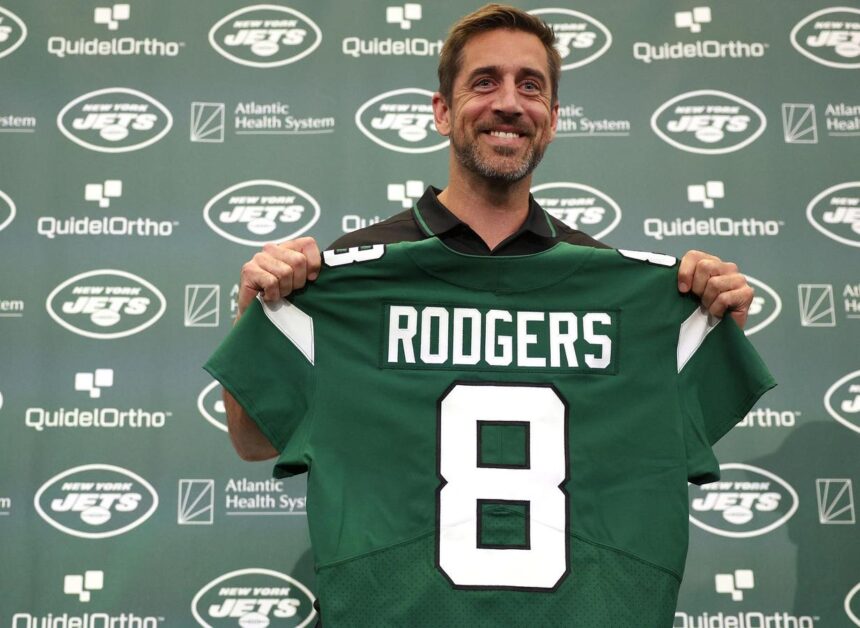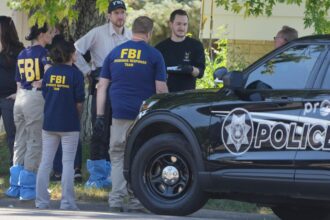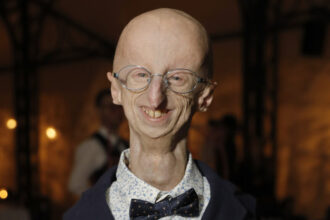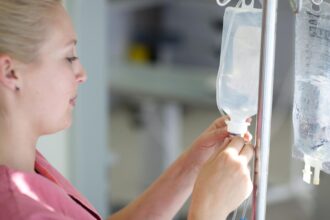FLORHAM PARK, NEW JERSEY – APRIL 26: New York Jets quarterback Aaron Rodgers poses with a jersey … [+]
After Aaron Rodgers tore his Achilles tendon in the September 11 game against Buffalo, four plays into the season, he knew who to call. It was world renowned orthopaedic surgeon, Dr. Neal ElAttrache, a sports medicine specialist and leader at the world-famous Kerlan-Jobe Orthopaedic Clinic, Head Team Physician for the Los Angeles Dodgers and the Los Angeles Rams. Rodgers’ goal of an accelerated return to the field as Jets quarterback, quicker than the usual range of 4-12 months of recovery from Achilles’ tendon reparative surgery, is not just a test of willpower or a pie-in-the sky aspiration. It is proving to be a realistic effort for the tough, motivated athlete.
Rodgers turns forty on December 2nd and he has a birthday present in mind, returning to practice on that day. He has said on “The Pat McAfee Show” that his speed of rehab has been the same since the injury occurred and we are going to push it as hard as we can. “It could change,” he said. “If I have a great week, this week, and next that could be accelerated.”
Safely returning to play after disruption of the thick, bandlike, longest, and strongest tendon in the body demands sufficient healing to avoid additional disruption, a catastrophic event that will set Rodgers back many months if it happens. The tendon is made up of fibrous connective tissue which includes type I collagen and elastin. It serves as the insertion of the powerful calf muscles, the gastrocnemius and soleus at its upper end. The lower end of the Achilles tendon inserts over a broad expanse of the back of the calcaneus, generally known as the heel bone.
EAST RUTHERFORD, NEW JERSEY – SEPTEMBER 11: Aaron Rodgers #8 of the New York Jets passes as he warms … [+]
The forces exerted on the Achilles tendon can exceed 1,000 pounds. When weakened by chronic injury or internal disruption, it can partially or completely tear. For Rodgers, the strength of the surgical construct, which includes screw-like implants driven into the calcaneus, attached to thick rope-like cords inserted through and around the tendon, combined with the strength of the healing bone-tendon interface, must withstand the instantaneous forces that Rodgers can expect on the field.
When the Achilles tendon is disrupted, the power of calf muscle contraction cannot be coupled to the movement of the ankle. Running is out of the question. Just walking up the stairs can be a struggle.
LOS ANGELES, CA – DECEMBER 29: orthopaedic surgeon, Dr. Neal ElAttrache (Photo by Jayne … [+]
Dr. ElAttrache repaired the disrupted tendon using state-of-the-art techniques he has honed over three decades of clinical practice. He used the Achilles SpeedBridge implant system. The system is a knotless 4-anchor construct. It secures the bottom end of the Achilles tendon to the calcaneus.
The expertise and experience of Dr. ElAttrache have been pivotal in Rodgers’ potential to achieve his goals of recovery. The value of making that call to the surgeon cannot be overstated. It was a gamechanger.
In Greek mythology, Achilles was the greatest warrior of the Trojan War, but he had a weakness. In an otherwise invulnerable body. The tendons that connected his calf muscles to the heel were vulnerable. Some might be tempted to compare Rodgers to that great warrior.
“Surgery went great yesterday,” Rodgers posted in September, alongside a photo of the happy patient resting in the hospital bed, garbed in gown, blue bonnet and a face mask pulled down to his chin. “Thank you for all the love and prayers and support. And thanks to…Dr. ElAttrache and his staff for starting me on the road to recovery.”
Returning to practice in under 3 months, and full-contact professional football, in under 4 months, is a goal fraught with risk of re-rupture of the surgically repaired connection. But like with all surgical interventions, and the post-operative rehabilitation process, risks are weighed against potential for reward. The decision of when to return to practice and then play starts with Rodgers but does not end there. Professional football players returning from injury must also pass through the gauntlet of the team physician, their own surgeon, and owners.
Eugene Curry, MD out of Dallas Texas has presented to the orthopaedic surgery community on the Achilles SpeedBridge Repair. If you asked him fifteen years ago what he was doing to repair the Achilles tendon, he was using a couple standard suture anchors, but said “I never felt quite good about the repair.” Five years ago, he described the SpeedBridge technique as highly successful and reproducible. He felt it is a stronger repair than with anchors alone. Dr. Curry described patients having the ability to bear weight earlier, shorten the period of immobilization, and benefit by a shortened recovery time.
Dr. Curry’s postoperative protocol is similar to the industry standard. It included 2 weeks in a splint with the foot and ankle flexed down, then 4-6 weeks weight-bearing as tolerated in a boot or cast with wedges. Each week the wedges are modified if the patient is in a boot. Physical therapy is part of the rehabilitation for regaining range of motion of the ankle and strengthening of the muscles. Dr. Curry returns patients to most activities by 5-6 months. He finds that full recovery can take up to one year or longer for some of his patients.
But Rodgers is, well, Aaron Rodgers. While he may not be Achilles, invincible, or immortal, he is as tough as nails. However, the biological principles of tendon and bone healing which govern the speed and success of his tendon repair healing proceed irrespective of Rodgers’ grit and determination. If he returns too soon, he will be the first to know it. The repair will fail, disrupting the tendon, or the tendon- bone connection. A second repair will be fraught with even more risk of complications, and a longer recovery process. Scar, stiffness, and weakness will make recovery from another surgical repair an uphill battle for the Jets quarterback.
Rodgers’ return to play timeline is aggressive, optimistic, bold, and possible. It contains plenty of risk for even a great quarterback. But if anyone can pull off a speedy, safe, and effective recovery, with such a renowned orthopaedic surgeon as Dr. Neal ElAttrache behind him, it is Aaron Rodgers.









